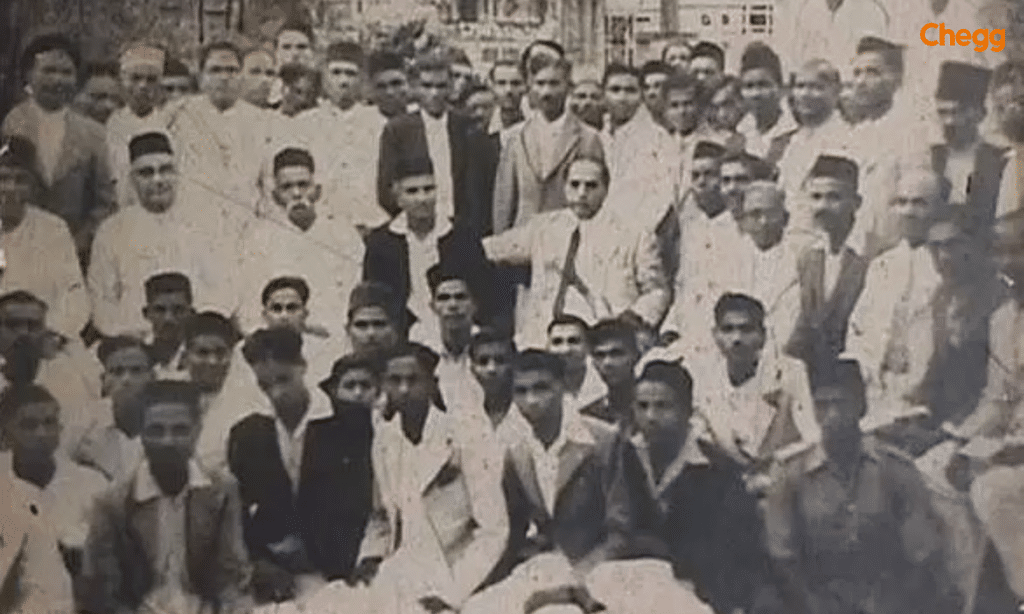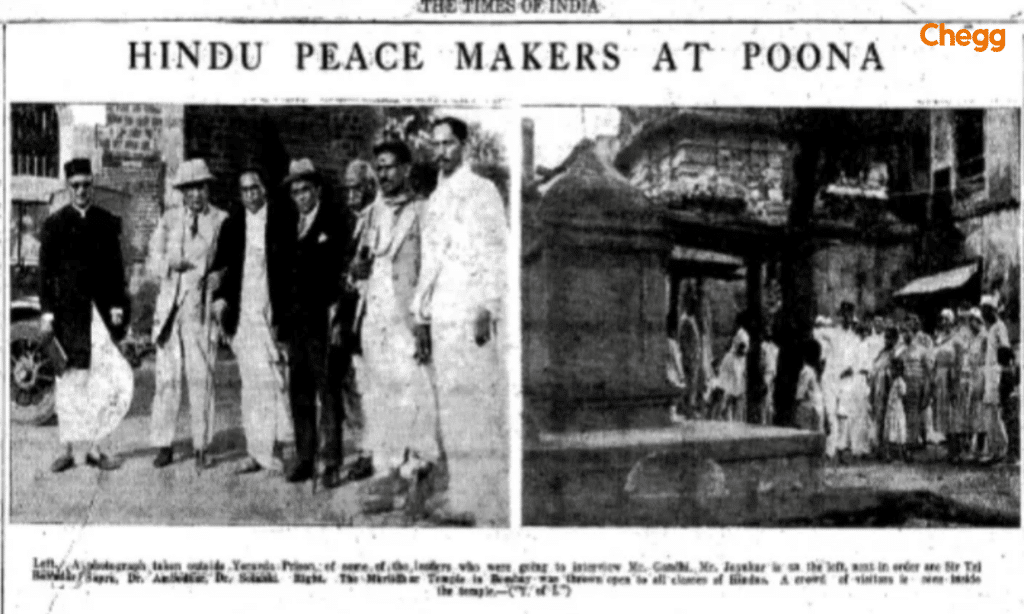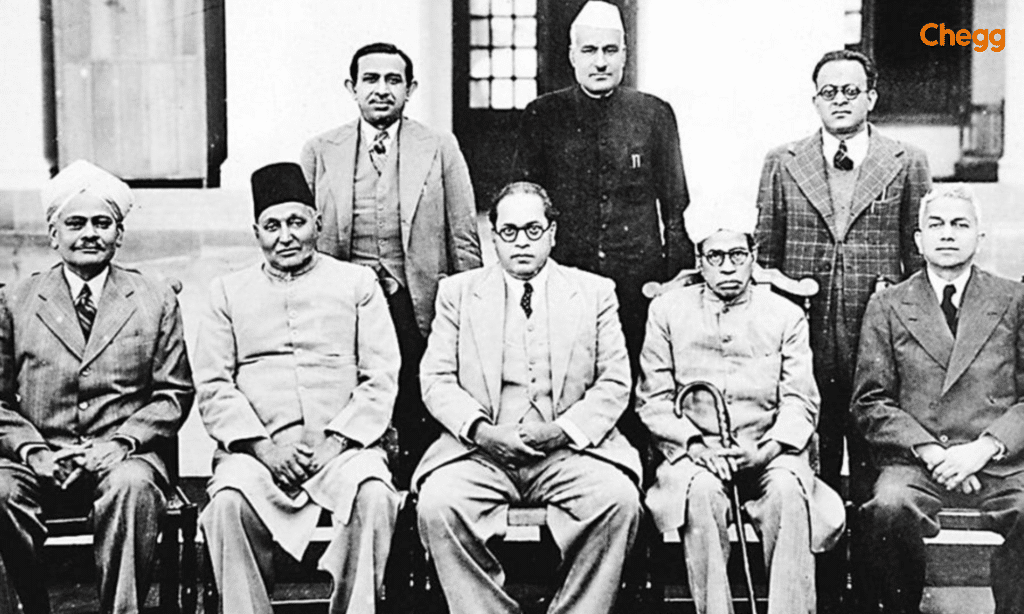
Quick Summary
Table of Contents
Dr Bhim Rao Ambedkar, the father of Indian Constitution, was born in a Dalit Mahar family on April 14, 1891. He was the last child of Ramji Maloji Sakpal. The so-called upper caste Hindus significantly discriminated against the Dalit Mahar caste, treating them as untouchables. Ramji Maloji Sakpal has worked in the British Indian Army and, after retirement, settled in Mhow, now in Madhya Pradesh. It was here that Bhim Rao Ambedkar was born.
Ambedkar dedicated his life to uplifting the social status and rights of Dalits in India. His lectures and writings spotlighting the discrimination faced by Dalits quickly established Ambedkar as a national leader in social reform. This reputation and expertise later led to his landmark appointment as Chairman of the Drafting Committee, where Ambedkar played the central role in framing independent India’s new Constitution.
A Famous quote by Dr. Bhim Rao Ambedkar:
I measure the progress of a community by the degree of progress which women have achieved.
– Dr Bhim Rao Ambedkar
The Indian Constitution is the foundation upon which the nation is built. It’s the supreme law of the land, outlining the core principles of governance.
What it Does:
A Historic Milestone:
Adopted in 1949 and coming into effect in 1950, the Indian Constitution marked the birth of the Republic of India. It’s one of the longest-written constitutions globally, with 470 articles categorized across 25 parts. These parts delve into various aspects of governing, from fundamental rights to the distribution of power between the central and state governments.
Dr Bhim Rao Ambedkar was the chief architect and referred to as the “Father of Indian Constitution.” Being an ambitious leader and social reformer, he dedicated his life’s work to fighting discrimination against Dalits. On August 29, 1947, he was appointed Chairman of the Drafting Committee tasked with framing India’s Constitution. To prepare, Ambedkar thoroughly studied the constitutions of 60 other nations.
After independence, the government recognized Ambedkar’s instrumental role by naming him India’s first Union Law Minister. He also laid important policy groundwork across roles – from establishing guidelines that shaped the Reserve Bank of India to championing labor reforms for the vulnerable as a member of the Viceroy’s Council. Ambedkar is rightly remembered as a transformative national leader due to his foundational impact spanning social justice, governance, and economics.
Bhimrao Ambedkar is known as the Father of Indian Constitution due to his instrumental role in its drafting and framing. Here’s a breakdown of his key contributions:
These significant contributions solidified his position as the architect of the Indian Constitution, earning him the title “Father of Indian Constitution.”

Dr. Bhim Rao Ambedkar, born into a lower-caste “untouchable” family, faced severe discrimination from an early age. His fellow students often ridiculed him and excluded him from basic classroom interactions. This painful experience gave him a firsthand understanding of the injustices faced by marginalized communities in India.
Despite these challenges, Ambedkar’s academic talent did not go unnoticed. The ruler of Baroda awarded him a scholarship in recognition of his excellence. This scholarship enabled him to pursue higher education at prestigious foreign institutions, including Columbia University in the United States and the London School of Economics in the United Kingdom. These experiences broadened his perspective and strengthened his resolve to bring about social reform in India.
After returning to India, Dr. Ambedkar took up the post of Defence Secretary in Baroda. However, he soon resigned in 1923 due to the continuing discrimination he faced, even in this high-ranking role. His experiences only reinforced his commitment to fight for equality and justice.
From 1927, Dr. Ambedkar began actively working to uplift Dalits. He led the Mahad Satyagraha to assert Dalits’ right to access water, founded the “Bahishkrit Hitakarini Sabha” to promote education and socio-economic progress among marginalized communities, and established the “All India Scheduled Castes Federation” to represent the interests of Dalits on a national scale.
Being born into a Dalit family, Ambedkar faced discrimination from his peers and society throughout his life. However, he took the leadership to reform the condition of Dalits in the country. He pushed for legislative reforms, recognition in educational institutions, etc. During his fight against the deeply rooted caste system in the country, he had to face the bias of the British and Indians. He considered untouchability a political issue and sought to dismiss it with political reforms. However, in this ideology, he was opposed by M. K. Gandhi. Gandhi thought that untouchability was more of a social issue.

Ambedkar led the movement against untouchability in 1927. He and his followers marched to demand the right to draw water from public wells and other water resources. Ambedkar also organized the march to allow Dalits entry to the temples. He negotiated the untouchables’ political and educational status with M. K. Gandhi in the Poona Pact of 1932. Under this, he facilitated reservation seats for Dalits in political positions and educational institutions.
Indian society still follows the social reforms carried out by the Father of Indian Constitution, the maker of the Constitution of India. He was a staunch supporter of equality, along with a thought-provoking writer. His works, from Annihilation of Caste to Thoughts on Pakistan, are still important in political literature. Various commemorations have honored him for his efforts in enhancing the country’s social structure and economic stability. Many institutions across the country bear his name. They renamed his birthplace, Mhow, to Dr. Ambedkar Nagar. His birthday, April 14, is observed as a holiday as well.
Dr Ambedkar’s quotes include, “I measure the progress of a community by the degree of progress which women have achieved.” Ambedkar worked for the lower castes of society to bring them self-esteem and better living conditions. He targeted his movements to secure equal rights for the untouchables, including access to safe drinking water, places of worship, etc.
He also considered education the most essential social tool for uplifting society. Ambedkar asked for separate electors for Dalits in the first Round Table Conference held in London in 1930. He worked towards the economic progress of the country by promoting industrialization. Dr Ambedkar proposed solutions for rural nationalism and collective farming.
| Personal Information | |
| Full Name | Bhimrao Ramji Ambedkar |
| Nickname | Babasaheb Ambedkar |
| Birthdate | April 14, 1891 |
| Birthplace | Mhow, Madhya Pradesh, India |
| Father’s Name | Ramji Maloji Sakpal |
| Mother’s Name | Bhimabai Sakpal |
| Education | 1. Elphinstone College, University of Mumbai 2. Columbia University, USA 3. London School of Economics, UK |
| Occupation | Social reformer, jurist, economist, politician |
| Religion | Buddhism |
| Family | Spouse: Ramabai Ambedkar Children: Yashwant, Gangadhar, Ramesh, Indu, Rajratna |
| Notable Accomplishments | 1. Has been given the title of “Father of Indian Constitution.” 2. Is still considered a leader and hero by Dalits, Scheduled Castes, and the country’s marginalized communities. 3. A strict believer in social justice, equality, and human rights, his ideas are still referred to in political and social debates. 4. Encouraged Dalits to convert to Buddhism to find a religion that does not discriminate against them. Also led the Navayana Movement to provide spiritual shelter for the country’s marginalised communities. 5. Considered one of the most essential figures to have shaped the ideology of modern India, his guidelines and ideas on social, political, and economic development are still celebrated. |
| Legacy | 1. Has been given the title of “Father of Indian Constitution.” 2. Is still considered a leader and hero by Dalits, Scheduled Castes, and the country’s marginalized communities. 3. A strict believer in social justice, equality, and human rights, his ideas are still referred to in political and social debates. 4. Encouraged Dalits to convert to Buddhism to find a religion that does not discriminate against them. Also led the Navayana Movement to provide spiritual shelter for the country’s marginalized communities. 5. Considered one of the most essential figures to have shaped the ideology of modern India, his guidelines and ideas on social, political, and economic development are still celebrated. |

Ambedkar initially aimed to ensure the representation of the people of the Scheduled Castes when he joined the Constitutional Assembly. However, they appointed him as the Chairman of the Drafting Committee.
Ambedkar strongly favored a parliamentary form of government, as observed in America, instead of the British model. He also strengthened the central government to uphold the Union of States of India.
Dr. Bhimrao Ambedkar favored a removable executive and a parliamentary form of government.
He also believed that the Constitution should include the Bill of Rights, based on the American Declaration of Independence. He established the fundamental rights of citizens of India to abolish the inequalities present in the community.
Dr Ambedkar thought that the rights provided a standard of conduct that the citizens should uphold. He was also firmly in favor of including Article 17, which abolishes untouchability of any form from the country. He pointed out that the Constitution establishes equality in the political sense. However, he found some inadequacies regarding the social and economic fronts. In 1948, the Constitution of India became one of the few written constitutions in the world. It is comprehensive and very carefully worded by the Drafting Committee.
Dr. Ambedkar, who drafted the Indian Constitution, always took active steps towards uplifting the country’s marginalized communities. This included leading movements that brought equal status to the people belonging to the Scheduled Castes. He also proposed a separate Dalit electorate, which M.K. Gandhi opposed. As a negotiation, the Poona Pact marked the first step towards the political upliftment of the “depressed castes,” with its signing. He also included Articles 17 and 46 in the Constitution. Article 17 illegalises untouchability of any form in the country. He recognized that this does not give any active rights to the people. However, it was still a step towards bringing the condition of the marginalized community to equality.
Article 46 emphasizes the educational and economic upliftment of the Dalits and other marginalized sections. It provides reservations in educational institutions, employment places, etc., to reduce social and economic inequalities. He was also an advocate of entrepreneurship and industrialization for the economic upliftment of society. He wanted land reforms to distribute land among the landless and backward castes of the community. His land reforms, economic guidelines, and establishment of the Tenancy Act are some of his outstanding achievements.
| Title | Year | Summary | Focus Area |
|---|---|---|---|
| Annihilation of Caste | 1936 | A powerful critique of the caste system advocating for its complete eradication, foundational for movements promoting social equality in India. | Social Justice & Equality |
| Castes in India: Their Mechanism, Genesis, and Development | 1916 | Explores the life and teachings of Gautama Buddha, highlighting principles of non-violence and social equality, aligning with Ambedkar’s vision for inclusivity. | Historical Analysis of Caste |
| The Problem of the Rupee: Its Origin and Its Solution | 1940 | Ambedkar’s analysis of the challenges faced by the Indian rupee proposes solutions for a more stable currency. | Economic Policy |
| States and Minorities | 1945 | A discussion on the concerns of minority groups in India, proposing frameworks for their protection and equal participation in society. | Minority Rights |
| Buddha and His Dhamma | 1957 | The Untouchables: Who Were They and Why Did They Became Untouchables? | Philosophy & Social Equality |
| The Untouchables: Who Were They and Why Did They Become Untouchables? | 1959 | An exploration of the historical roots and social conditions leading to the marginalization of the Dalit community. | History of Untouchability |
Also Read:-
Amendment in the Indian Constitution: An Overview
Salient Features of the Indian Constitution: An Overview
The Parts of the Indian Constitution: A Comprehensive Guide
Indian Independence Day Speech: A Tribute to Freedom
Ambedkar, who is the father of the constitution, faced various struggles during the drafting of the document. The first challenge was that he had to create an amalgam of the idealist and realist ideas of Nehru and Patel, respectively. Dr Ambedkar also had to draw clear solutions for the debates on minority rights, federalism, etc.
Dr also faced challenges while trying to change the rigid social order in Indian society. He wanted to promote social justice and equality, for which different leaders had different ideas and viewpoints. He wanted to build a secular India that treats all its citizens as equals, which is a humongous task for a country as varied as India.
Ambedkar wrote the Indian Constitution based on his Buddhist principles. He thus introduced the values of equality, liberty, justice, and fraternity in the Constitution. Ambedkar worked on the Constitution for 2 years, 11 months, and 18 days after the 114 days of meetings held by the Drafting Committee. He kept at work even through his deteriorating health.
| Founding Fathers of the Indian Constitution | Contributions |
|---|---|
| Dr. B.R. Ambedkar | The first Prime Minister made significant contributions to constitutional debates. |
| Pandit Jawaharlal Nehru | Prominent lawyer with significant legal contributions to the Constitution. |
| Sardar Vallabhbhai Patel | Lawyer, writer, and politician, active in drafting the Constitution. |
| K.M. Munshi | Lawyer, writer, politician, active in drafting the Constitution. |
| Alladi Krishnaswamy Iyer | Integrated princely states are invaluable in constitutional discussions. |
| N. Gopalaswami Ayyangar | Drafted provisions for Jammu and Kashmir’s special status. |
| Maulana Abul Kalam Azad | The First Minister of Education contributed to education and cultural reforms. |
| D.P. Khaitan | Legal scholar, enriched constitutional discussions with his expertise. |
After the promulgation of the Constitution on January 26, 1950, Ambedkar, also known as the Father of the Indian Constitution, returned to Bombay to recover his health. He acknowledged that the Constitution still had its limits. However, various essential parts of the documents, such as federalism, liberal democracy, and reforms for minorities, showcase the impact of the father of the Indian Constitution. A year later, in 1951, he resigned from the post of Law Minister because of differences in views between the government and his. Even after his death, his social reforms reflected the people of the Scheduled Castes and other minority communities.
For his contribution as the Chairman of the Drafting Committee, Dr B.R. Ambedkar is known as the father of Indian Constitution.
Some prominent works of Bhim Rao Ambedkar include Annihilation of Caste, Waiting for Visa, The Problem of the Rupee: Its Origin and Its Solution, etc.
Dr Ambedkar set up various institutions for the upliftment and representation of minorities in Indian society. These include the All India Scheduled Castes Federation, People’s Education Society, and Bahishkrit Hitakarini Sabha.
Babasaheb includes fundamental rights such as equality, freedom of speech, protection against discrimination and untouchability, etc.
Ambedkar, also known as the father of Indian constitution, belonged to the Dalit community, formerly known as the Scheduled Castes or untouchables.
Dr. B.R. Ambedkar is considered the principal architect of the Indian Constitution.
The first Father of Law in India is often considered to be Dr. B.R. Ambedkar, due to his pivotal role in drafting the Indian Constitution and his contributions to legal reforms.

Authored by, Amay Mathur | Senior Editor




Amay Mathur is a business news reporter at Chegg.com. He previously worked for PCMag, Business Insider, The Messenger, and ZDNET as a reporter and copyeditor. His areas of coverage encompass tech, business, strategy, finance, and even space. He is a Columbia University graduate.
Editor's Recommendations
Chegg India does not ask for money to offer any opportunity with the company. We request you to be vigilant before sharing your personal and financial information with any third party. Beware of fraudulent activities claiming affiliation with our company and promising monetary rewards or benefits. Chegg India shall not be responsible for any losses resulting from such activities.
Chegg India does not ask for money to offer any opportunity with the company. We request you to be vigilant before sharing your personal and financial information with any third party. Beware of fraudulent activities claiming affiliation with our company and promising monetary rewards or benefits. Chegg India shall not be responsible for any losses resulting from such activities.